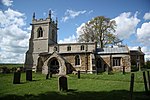Whissendine railway station
Disused railway stations in LeicestershireEast Midlands railway station stubsFormer Midland Railway stationsPages with no open date in Infobox stationRailway stations in Great Britain closed in 1955 ... and 2 more
Railway stations in Great Britain opened in 1848Use British English from March 2015

Whissendine railway station was a station serving the villages of Whissendine in Rutland and Wymondham and Edmondthorpe in Leicestershire. The station itself was about one and a half miles from each, and was in Leicestershire. It opened in 1848 on the Syston and Peterborough Railway and was originally named Wymondham but by 1863 it had been renamed Whisendine (with one s).
Excerpt from the Wikipedia article Whissendine railway station (License: CC BY-SA 3.0, Authors, Images).Whissendine railway station
Melton Wymondham
Geographical coordinates (GPS) Address Nearby Places Show on map
Geographical coordinates (GPS)
| Latitude | Longitude |
|---|---|
| N 52.7406 ° | E -0.7622 ° |
Address
LE15 7HH Melton, Wymondham
England, United Kingdom
Open on Google Maps











